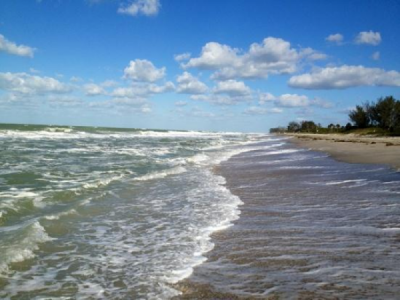
Posted on April 10, 2019
SARASOTA COUNTY — Residents on Manasota Key who fear their homes could be washed away by the Gulf of Mexico will finally get the protection they desperately need for their properties.
The Sarasota County Commission on Tuesday unanimously approved a joint beach renourishment project with Charlotte County that would restore roughly 50 feet of sand to the shoreline on a four-mile stretch from Blind Pass Park in Sarasota County to Don Pedro-Knight Islands Beach in Charlotte County. The total cost of the joint project is estimated at $35.3 million. The Sarasota County side — extending from Blind Pass Park to the Charlotte County line and including 50 beachfront homes — has a projected price tag of roughly $8.1 million with the state expected to cover a portion of the cost. About 309,000 cubic yards of sand would be added to the beach in Sarasota County, county documents show.
The Charlotte County side of the project — which has already received approval from the jurisdiction’s commission — is expected to cost just more than $27 million, which includes potential contributions from the state and federal government, documents show. Roughly 879,000 cubic yards of sand would be used for the entire joint project. The sand would be taken from nearby offshore areas, with work expected to begin in November, Sarasota County officials said Tuesday.
Officials from both counties have said that joining forces to make the renourishment a regional project increases the chances of securing state funding. The regional project currently ranks third on the state’s list of requests, making it likely that funding from Florida will come through, officials have said.
The project “needs to roar ahead,” Commissioner Al Maio said.
County officials plan to return to the commission later with financing options for the joint project.
The commission also directed staff to research financing options for potentially rebuilding severely eroded parts of Manasota Key near the joint project. The additional work would extend north from the joint project at Blind Pass Park to 7250 Manasota Key Road. The county must decide if it wants to add 20, 30 or 50 feet of shoreline to the beach that includes a stretch of 30 beachfront homes — if it goes forward with the endeavor. The northern project ranges in price from $5.8 million to $14 million, county officials estimate. New hard bottom, or marine habitat, would need to be created to mitigate any effects the project has on existing ones, making the price considerably greater depending on how much sand is used. The possible project would be done with inland fill from a sand mine in the center of the state, with that sand brought by truck instead of pumped through a dredge.
Potential financing options for both projects include state funds and using money from the Tourism Development Tax and a Municipal Service Benefit Unit, which would require beachfront property owners benefitting from the project to chip in. Those options are similar to financing methods the county used when it renouirshed Siesta Key Beach years ago, which has only been renourished twice in its history, county officials said.
A steady stream of Manasota Key residents spoke Tuesday in support of the projects, alerting commissioners of how critical the erosion has become.
Resident Betty Gawthrop, who has lived on Manasota Key for more than two decades, said her home has been exposed to the waves. She’s used large sandbags in recent months to protect her home from the encroaching ocean.
“The beach is so much less than when I moved here,” she said. “My house has been undermined by the Gulf coming in every now and then, and even though we have put in the sandbags, the water comes up over them. It’s been washed out behind them because the waves come in and storms happen.”
Later in the meeting, commission Chairman Charles Hines suggested the county consider hardening its beaches — potentially with seawalls to protect infrastructure — because expensive beach renourishment projects are temporary.
“If we keep going the way we’re going, we’re not dealing with our constituents on the keys and the problem that they’re facing every day,” Hines said of using renourishment as the only solution to erosion.
Source: heraldtribune.com





